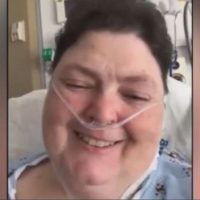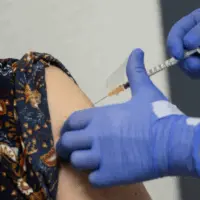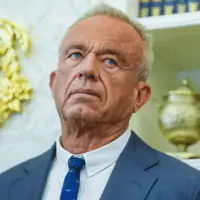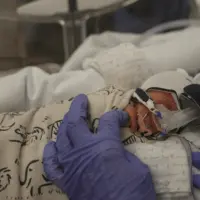
 ABC NewsBy JON SCHLOSBERG and KAYLEE HARTUNG, ABC News
ABC NewsBy JON SCHLOSBERG and KAYLEE HARTUNG, ABC News
(NEW YORK) — With a vaccine still months or years away, and no magic drug or miracle cure for the coronavirus, the cruel realities of this virus can hit families incredibly quickly.
But with the scientific world working around the clock on potential lifesaving breakthroughs, there is hope.
Within a few days, Heather Griffin went from dropping her dad off at a hospital to dropping off her mother there too — then, one after another, within 24 hours, both her parents were transferred into the ICU and put on ventilators.
“If I would have lost either one of them … it would have been like half my world gone,” Griffin told ABC News’ Kaylee Hartung.
Connie and Marvin Griffin have been married for 33 years. They rarely leave each other’s side, and after raising two kids, nothing brings them more joy these days than being grandparents to Heather’s four-year-old daughter.
With both of them intubated and in the ICU, a possible lifeline emerged when the family needed it most: experimental convalescent plasma therapy.
The immune system produces antibodies to help fight viruses, and three to four weeks after a person recovers from COVID-19 their plasma can be drawn to see if contains those coveted cells. If it does, the antibodies can be injected into someone else who may be struggling to produce them.
The treatment was first used to combat the Spanish Flu in 1918.
“Thus far with plasma and from all the history that we have seen with this therapy, it appears that it is much more likely to help than it is to harm when used correctly,” said Doctor Roberto Colon, who leads the team pioneering this possible treatment at Premier Health Systems in Dayton, Ohio.
Premier Health is one of the first hospitals in the country to use the Food and Drug Administration-approved plasma test protocols developed by the Mayo Health Clinic.
“In a span of about two weeks, we were able to bring an idea of convalescent plasma all the way from concept to actual implementation of widespread use for an entire community,” Colon said.
While Colon’s team was racing to implement the program, the urgent calls for donors began circulating on social media.
An emergency room nurse in Cincinnati, Lindsey Hayko, saw the call on social media and decided to investigate the donation process. She’s among the approximately 80% of COVID-19 patients who have recovered from the virus while only experiencing mild symptoms.
Hayko was symptom-free for more than two weeks and was able to get a negative test, clearing the way for her to donate her plasma.
“Being an E.R. nurse, I feel like I should have been out there and I should have been at work and I should be helping everybody,” Hayko told ABC News. “So it was nice that I could do this.”
Hayko made the one-hour drive to Dayton’s Community Blood Bank and became just the second recovered COVID-19 patient to donate plasma there.
Each convalescent plasma donation can be injected in as many as four patients, so Hayko’s two hours at the clinic had the potential to save up to four people’s lives. Premier Health told ABC News they can inject the plasma donations as soon as the next day.
After consulting with her family and doctors, Heather Griffin decided her mom would receive the plasma therapy. Her dad was responding well to his treatment plan, whereas her mom had preexisting conditions and a weaker immune system.
Six days after receiving the plasma, Connie was taken off the ventilator — and she says there’s no doubt why.
“I don’t know that I’d have made it without that treatment,” she told ABC News.
In addition to Connie, eight other patients at Premier Health have now received convalescent plasma therapy.
“We have been seeing glimmers of hope that this is working,” Dr. Colon told ABC News. “We want to make sure that we hold that judgment until we get the aggregate data.”
Access to this experimental treatment is not as easy to get throughout the country as it is in Dayton.
The country “needs more donors and more distribution of plasma,” Dr. Scott Wright at the Mayo Clinic told ABC News. At least 1,485 acute care hospitals across the U.S. have signed up to be part of the Mayo Clinic’s expanded access convalescent plasma test protocol.
So far, at least 1,280 patients have been identified as candidates for the therapy, but only about 25% of those have received plasma.
As more and more people nationwide join the ranks of the recovered, Dr. Wright says the critical need for donations could prevent future outbreaks.
“If this works, we will have plasma and antibodies stored for the fall,” he told ABC News.
Hayko says she plans to donate once a week as long as she has the antibodies that can help.
“You feel like you’re hopeless because you tested positive for this virus that’s caused a whole pandemic, so you just feel hopeless and like there’s nothing that you can do about it,” Hayko told ABC News. “Please go out and donate your plasma, because there is so much that we can do about it.”
Hayko may never know everyone whose life her plasma may have saved, but she says that’s OK.
“They called me and said that my donation went to someone and it was helping them. So I don’t know exactly who that person is, but I don’t think it really matters either,” Hayko said.
A recovering Connie Griffin had this emotional message from her hospital bed for her plasma donor: “I am so thankful that you gave a donation of life … because that’s what it was for me.”
“If they hadn’t donated, I would not have the possibility and I just thank them very much,” Griffin said.
Marvin Griffin, in the meantime, was able to go home to his family over the weekend. Now, Marvin, Heather and the rest of the family eagerly await Connie’s return home.
Nineteen days after going on a ventilator, and 14 days after getting the experimental plasma treatment Connie received a negative test on April 21.
She has to go into rehab first, but hopes to be home sometime soon.
When asked about the first thing she’ll do when she leaves the hospital, Connie said the answer was simple.
“Go sit on the front porch somewhere, sit outside … and just be with my family,” she told ABC News. “To see my husband and my kids, my granddaughter, would be the most wonderful thing.”
Copyright © 2020, ABC Audio. All rights reserved.














